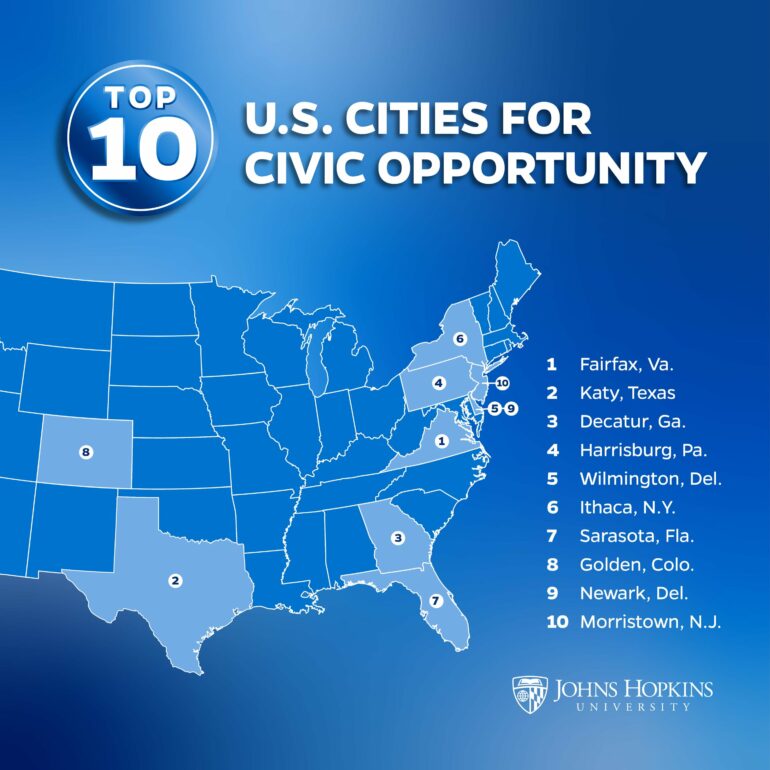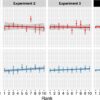People in many parts of the United States possess few chances for the robust community engagement that underpins healthy democracies, according to a new report that for the first time maps civic opportunity across the country.
The heat map created by Johns Hopkins University’s SNF Agora Institute, reveals patterns of inequality in civic opportunity tied to race, class, immigration status and education. Researchers also found that a great deal of civic engagement happens through local faith institutions and social and fraternal organizations, not D.C.-based advocacy organizations that tend to carry political clout.
The report is the initial phase of an ambitious effort to map the modern agora, referring to the lively assembly places of ancient Greece often considered to be the birthplace of democracy. The work is published in Nature Human Behaviour.
“If you want to strengthen civic engagement, the first thing you have to do is map what the civic infrastructure of the United States looks like. You can’t fix what you can’t see,” said Hahrie Han, director of the university’s SNF Agora Institute and a professor of political science.
“First you have to be able to see a picture of the whole, then you can figure out how you target investments to catalyze the kind of reforms that we need to rebuild the modern-day agora.”
The team worked with big data and computational tools to develop a more precise map of civic opportunity than previously possible. They started with non-profit organizations registered with the Internal Revenue Service—1.8 million of them.
To learn more about the groups and where they operate, the team layered that information with data from more than 1 million organizational websites and the U.S. Census. They then identified and classified the organizations actually generating true civic opportunity—coming up with 564,559 groups.
Civic opportunity scores per capita decreased as poverty levels increase, the team noticed, and wealthier, whiter, better-educated communities were more likely to have civic opportunity. They also found that inequality in civic opportunity affects a community’s ability to come together to solve problems, such as forming mutual aid organizations during the pandemic and decreasing vaccine hesitancy.
For instance, every county in Connecticut is among the highest providers of civic opportunity but most of Mississippi is among the lowest.
“What we find is that there are patterns of inequality in civic opportunity based on things like race, class, immigration status, and education. So wealthier, whiter communities are likely to have more civic opportunities than poorer, less white communities,” Han said.
The most common organizations providing civic opportunity across America are religious organizations and social-fraternal organizations (such as Rotary clubs, fraternities, ethnic clubs, and religious groups), which together make up 37% of all civic opportunity organizations. In 85% of counties, they are the top providers of civic opportunity.
“One of the things that was surprising was the extent to which the highest providers of civic opportunity are still faith institutions and social and fraternal organizations,” Han said.
“The kind of organizations that tend to be talked about in public affairs and politics tend not to be the kind of organizations providing civic opportunities to people across America. I’m in many, many conversations with democracy reform people and I can’t think of a single person who’s said we’re going to go find the bridge players of Topeka, but that’s where people are engaging with other people.”
Because it’s clear that the groups providing civic opportunity are vastly decentralized, the question becomes how to reach these people, Han said.
“It’s encouraging that there are places where people are still gathering,” she said. “To me the problem isn’t the places people are gathering, it’s that the political elite are ignoring those places. The first rule in trying to engage people in democracy is that you have to meet people where they are.”
The team plans to make the data publicly available and ideally searchable by ZIP code so that people can find these organizations within their communities.
The Johns Hopkins team also included associate research scholar Milan de Vries and research fellow Jae Yeon Kim.
More information:
The unequal landscape of civic opportunity in America, Nature Human Behaviour (2023). DOI: 10.1038/s41562-023-01743-1
Provided by
Johns Hopkins University
Citation:
New heat map charts unequal civic opportunity in the US (2023, November 13)



